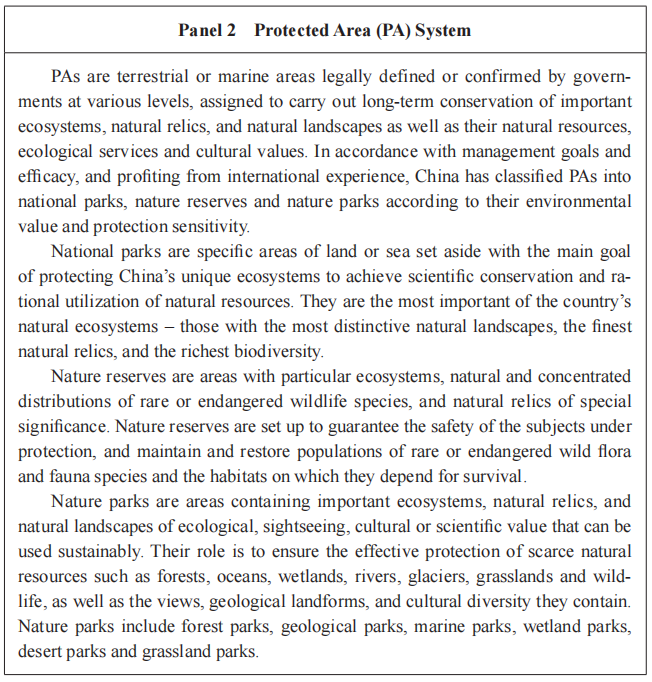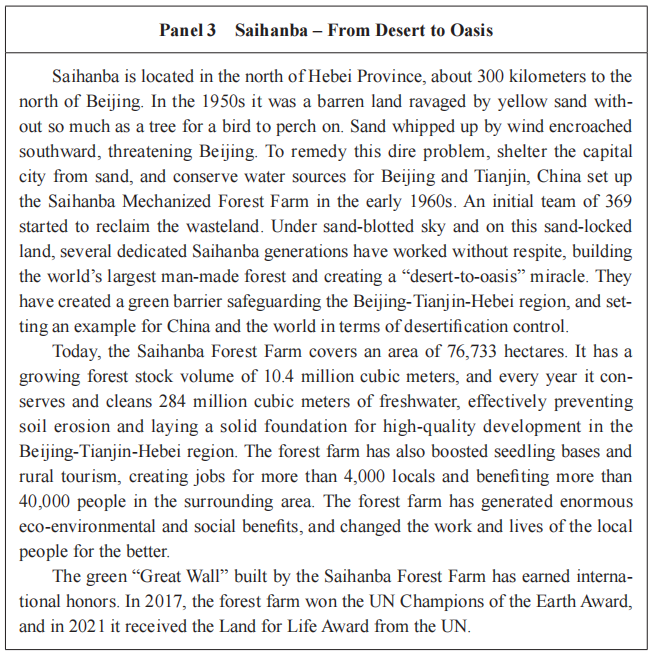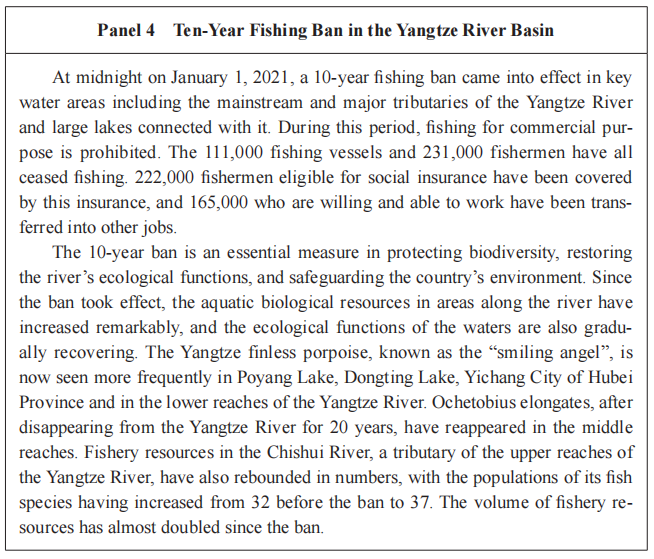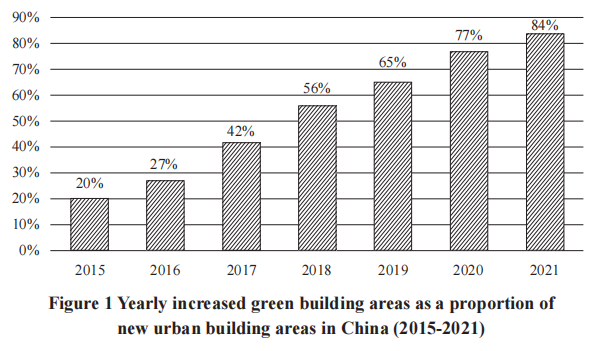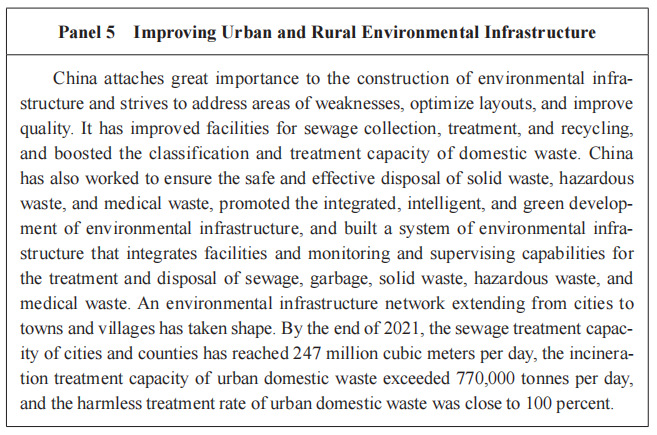Xinhua | January 19, 2023
II. A Basic Green Territorial Configuration Is in Place
China is making efforts to optimize its governing system of territorial space. The country has strengthened the overall planning and coordinated management and control of territorial space for working and living and for the environment. It has intensified efforts to protect and restore ecosystems, effectively expanded the capacity of the eco-environment, and promoted the rapid accumulation of natural wealth and eco-environmental wealth, leading to historic, transformative, and comprehensive changes in eco-environmental protection and providing strong support for the sustainable and healthy development of the economy and society.
1. Optimizing the development and protection of territorial space
A country's territorial space is the carrier for green development. China has implemented a functional zoning strategy and established a unified territorial space planning system that is science-based, efficient and built upon clearly defined powers and responsibilities. Taking into consideration factors such as population distribution, regional economic structures, land use, and eco-environmental protection, it has planned for the development and protection of territorial space with a holistic approach, so as to achieve higher-quality and more sustainable development of its territorial space.
China has integrated different plans into a single master plan for territorial space development. It has integrated functional zoning, land use, urban and rural planning, and other spatial planning into a unified territorial space plan. A comprehensive system integrating planning approval, implementation supervision, regulations, policies and technical standards is taking shape. The role of territorial space planning has been strengthened in guiding and constraining various specific plans. It has sped up the drafting of various plans for territorial space at all levels. As a result, an overall master plan will eventually be drawn up for the development and protection of territorial space.
Concerted efforts have been made to optimize the use of territorial space. Based on the results of national land resource surveys, China has carried out an evaluation of the carrying capacity of resources and the environment, and suitability of land development. It has scientifically designated agricultural, ecological, urban and other functional zones, and improved the territorial space layout that consists of three major zones — main agricultural production zones, key ecosystem service zones and urbanized zones. To strengthen national and regional eco-environmental security, China has designated permanent basic cropland, drawn red lines for eco-environmental protection, delineated boundaries for urban development, and set protection lines for all types of sea areas, in a coordinated manner. It has established centralized control over the use of territorial space and ensured that these lines are not crossed.
China has strengthened the management of key ecosystem service zones and endeavored to prevent and control eco-environmental risks. County-level administrative units that perform important ecological functions such as water conservation, soil and water conservation, inhibiting winds, fixing sand, and protecting biodiversity are designated as key ecosystem service zones, which should focus on protecting the environment and providing eco- environmental products and be restricted from large-scale industrialization and urbanization. As a result, China's natural ecosystems are generally stable or improving, eco-environmental services have improved, and the supply of eco-environmental products has continued to increase.
2. Strengthening eco-environmental conservation and restoration
Mountains, rivers, forests, farmland, lakes, grasslands and deserts are communities of life. China has stepped up systematic, comprehensive, and law-based environment governance, tackling problems at their sources. Prioritizing protection and focusing on natural restoration, it has vigorously pressed forward with the protection and restoration of ecosystems, so as to build a solid national eco-environmental security barrier and strengthen the foundations for the sustainable development of the Chinese nation.
A new type of protected area (PA) system has been set up. PAs are major platforms for eco-environmental conservation. China is developing a PA system with national parks as the mainstay, supported by nature reserves and supplemented by nature parks. It has created its first batch of five national parks — the Three-River-Source National Park, the Giant Panda National Park, the Northeast China Tiger and Leopard National Park, the Hainan Tropical Rainforest National Park, and the Wuyishan National Park. It is making steady progress in building national parks in environmentally important regions. As of the end of 2021, nearly 10,000 PAs of various types and levels had been established, covering more than 17 percent of China's land area, bringing under effective protection 90 percent of its natural terrestrial ecosystem types and 74 percent of key state-protected wildlife species.
Setting up scientific eco-environmental conservation red lines (ECRLs). ECRLs are the lifeline of national eco-environmental security. China has brought functional areas of vital importance, exceedingly fragile areas, and areas of potentially vital eco-environmental value within the scope of the ECRL framework. More than 30 percent of China's land area — including integrated and optimized PAs — is now under the protection of ECRLs. Through drawing ECRLs and drafting ecological protection and restoration plans, the country has consolidated an overall eco-environmental conservation configuration composed of Three Eco-zones and Four Shelterbelts — the Qinghai-Tibet Plateau Eco-zone, the Yellow River Eco-zone (including the Loess Plateau Ecological Barrier), the Yangtze River Eco-zone (including the Sichuan-Yunnan Ecological Barrier), and the Northeast, North, South, and Coastal Shelterbelts.
Carrying out major projects for the conservation and restoration of key national ecosystems. With a focus on major national eco-environmental functional areas, ECRLs and PAs, China has launched projects for holistic conservation and restoration of mountains, rivers, forests, farmland, lakes, grasslands and deserts, taking comprehensive and systematic measures to deal with problems by addressing their root causes. It has carried out shelterbelt and natural forest protection and restoration programs such as the shelterbelt program in northeast China, north China and northwest China, programs returning marginal farmland to forests and grasslands, the program for ecological restoration of abandoned mines, the Blue Bay environment improvement initiative, the coastal belts protection and restoration program, the comprehensive management of the Bohai Sea water environment, the conservation and restoration of mangrove forests, and other restoration and rehabilitation projects of significant eco-environmental importance. China has carried out large-scale afforestation projects, steadily increased the area of forests, grasslands, wetlands, rivers and lakes, and effectively reversed the trend of desertification.
From 2012 to 2021, 64 million hectares of trees were planted. During this period, desertification prevention and control was carried out over 18.53 million hectares of land, and 40 million hectares of land were improved through sowing grass, and more than 800,000 hectares of wetland were added or restored. In 2021, the forest coverage ratio hit 24 percent, while the forest stock volume grew to 19.5 billion cubic meters. Both figures represented 30 consecutive years of growth, making China the country with the highest growth in forest resources and the largest area of man-made forest. China is also the first country to realize zero net land degradation — its desertified and sandified areas are both shrinking, and this is helping the world to reach the global goal of zero net land degradation in 2030. Since 2000, China has led the world in greening the planet, contributing around one fourth of the newly added green areas in the world.
3. Promoting the green development of key regions
China gives full play to the guiding role of major strategies for regional development and the implementation of these strategies, based on prioritizing eco-environmental conservation and promoting green development. It works to build the key regions into pioneers and models in green development to boost green social and economic development across the country.
Pushing for breakthroughs in environmental protection in the coordinated development of the Beijing-Tianjin-Hebei region. The strategy for the region's coordinated development has been implemented, spurring the integrated development of areas such as transport, environment, industry and public services, and strengthening joint prevention and control of environmental problems. With the region as a focus, comprehensive efforts have been made to address overexploitation of groundwater in north China, with the groundwater level going down continuously since the 1980s being reversed. In this region, Xiongan New Area is being built according to forward-looking plans and high standards, with a focus on developing it into a destination for entities relocated from Beijing as their functions are non-essential to Beijing's role as the capital. Xiongan will be built into an eco-friendly exemplar city of high-quality green development with a rational layout, a good balance of blue water, green areas, clean air, clear skies and urban facilities. In 2021, in 13 cities in the region, 74 percent of days had good air quality. This was an increase of 32 percentage points compared with 2013. Beijing has set an example in air quality control for the world.
Promoting well-coordinated environmental conservation and avoiding excessive development while developing the Yangtze River Economic Belt. The Yangtze River is the mother river of the Chinese nation, and a powerhouse for China's development. The restoration of the Yangtze River's eco-environment is a top priority. China is coordinating economic development and environmental protection and building an economic belt epitomizing green development and harmony between humanity and nature.
Taking advantage of the opportunities offered by industrial integration, the Yangtze River Economic Belt is building a green industrial system and accelerating its green economic transformation. A tough battle has been launched to protect and restore the eco-environment in the Yangtze River Basin: Intense efforts have been made to carry out the "4+1" project — the treatment of urban sewage and garbage, chemical pollution, agricultural non-point source pollution, ship pollution and tailing pond pollution; a comprehensive 10-year fishing ban in the Yangtze River Basin has been implemented; action has been taken to regulate banks development projects and remove illegal dykes. Since 2018, unauthorized structures along 162 kilometers of the river banks have been demolished, more than 12 square kilometers along the banks have been re vegetated, and 4,533 hectares have been returned to water. The water quality at the state-monitored sections of the mainstream of the Yangtze River has reached Grade II level (the second best level) for the past two years.
The pioneering role of the Yangtze River Delta region in green development. The construction of the Yangtze River Delta Integrated Green Development Demonstration Zone will be accelerated, to explore ways to translate eco-environmental strengths into social and economic benefits, and ways for the region to transition from coordinated project execution to regional integrated institutional innovation. With picturesque scenery, a rich culture, specialty industries, and a cluster of innovation resources, the region will lay a solid foundation for green development, and develop into a hub for green and innovation-driven development.
Eco-environmental conservation and high-quality development in the Yellow River Basin. Protecting the Yellow River is a long-term strategy of fundamental importance to the Chinese nation. China has made coordinated plans and carried out ecological protection and improvement in the entire Yellow River Basin, including soil erosion and desertification control in its upper and middle reaches and comprehensive treatment of river courses and banks in the lower reaches. The sediment load of the Yellow River has steadily fallen, which helps to ensure its safety. Water availability has been a determining factor in urban and industrial development, agriculture, and population distribution. A path of intensive water-conservation has been followed so that water security has been effectively ensured, water resources are used efficiently, and the ecology has improved. Areas along the Yellow River are being protected in order to carry forward and disseminate the Yellow River culture, develop specialty industries and nurture new industries and business models. This has raised both the eco-environmental and economic value of the river, to the benefit of the people.
Building a beautiful Guangdong-Hong Kong-Macao Greater Bay Area. China has vigorously improved the quality of the eco-environment in the bay area, explored green and low-carbon urban construction and operation models, and promoted sustainable development, making its skies bluer, mountains greener, and water clearer. The area will enjoy a safe and beautiful eco-environment, a stable society, and cultural prosperity.
4. Building a beautiful home with a pleasant living environment
Urban and rural areas are the carriers of human settlements and activities. China integrates the philosophy of green development into urban and rural construction, and promotes beautiful cities and beautiful countryside initiatives. With priority given to environmental pollution control, China strives to improve the living environment to build a beautiful home featuring lush mountains, green fields, singing birds, and blossoming flowers.
Building beautiful cities featuring harmony between humanity and nature. China has placed great emphasis on urban eco-environmental conservation and has adopted a people-centered approach to urbanization. It has made sound plans for spaces for working, living and eco-environmental conservation, and has worked to make cities livable, resilient and smart. The aim is to build cities into beautiful homes where humanity and nature coexist in harmony. In pursuing urbanization, China respects and accommodates the requirements of nature. It has made use of mountains, waters, and other unique landscapes to integrate cities into nature, so that urban dwellers can enjoy the view and are reminded of their rural origins. Efforts have been made to expand urban eco-environmental space through construction of national garden cities and forest cities, as well as parks and greenways in cities. With increased greenery coverage, the urban eco-environment has been effectively restored. From 2012 to 2021, green coverage of built-up urban areas increased from 39 percent to 42 percent, and the per capita area of park greenery has increased from 11.8 square meters to 14.78 square meters. Great efforts have been made to construct green and low-carbon buildings, and renovation of existing ones has been promoted, contributing to increasingly higher energy efficiency.
Building a beautiful and harmonious countryside that is pleasant to live and work in. Green development is a new driver of rural revitalization, and China is exploring new paths for green development in rural areas. It is actively developing new industries and new forms of business such as eco-agriculture, rural e-commerce, leisure agriculture, rural tourism, health, and elderly care, while advancing projects to protect and restore ecosystems. These efforts allow China to approach its goal of having strong agriculture and a beautiful and revitalized countryside. China is continuing to redevelop the whole rural living environment and steadily advancing the construction of modern and livable homes with sanitary toilets in rural areas, strengthening the treatment and recycling of domestic waste and sewage. As a result, more and more rural areas have access to safe and clean water, paved roads, streetlights, and clean energy. With an improved environment, the vast rural areas have become more sustainable. Lush groves, orchards, and gardens of flowers and vegetables set each other off, and the splendid pastoral scene is a treat for the eyes. A beautiful countryside where the skies are blue, the lands are green, and the waters are clear brings people delight with its scenic view. Greater efforts have also been made to protect and utilize traditional villages and carry forward their fine traditions, which have increased their cultural charm.
Taking further steps to prevent and control pollution. The environment has a significant impact on quality of life. Green mountains display beauty, and blue skies bring happiness. China is curbing pollution in a law-based, scientific, and targeted way. Priority has been given to addressing the thorniest problems of air, water and soil contamination that are of greatest concern to the public. Effective measures have been taken to keep skies blue, waters clear, and land pollution-free. The mechanism of coordinated prevention and control across regions and approaches in dealing with heavy air pollution have achieved remarkable results. The average PM2.5 density of China's cities at prefecture level and above dropped from 46 micrograms per cubic meter in 2015 to 30 micrograms per cubic meter in 2021. On 87.5 percent of the days in 2021, people enjoyed good air quality. China is making the fastest progress in air quality improvement. With an accelerated pace in curbing industrial, agricultural and domestic pollution sources, and in regulating water ecological systems, China has significantly reduced seriously polluted water bodies and sub-standard water bodies, and the safety of drinking water is ensured. In 2021, the proportion of surface water at or above Grade III in the country's five-tier water quality system reached 84.9 percent. China has banned the import of foreign waste, fulfilling its goal of "zero import" of solid waste while basically bringing the threat of soil contamination under control. Brilliant blue skies are dotted with white clouds during the day; when the sun sets, twinkling stars pattern the firmament. The shores are green and the waters are clean, with fish gliding under the clear water. People are breathing fresher air, drinking cleaner water, and eating safer food. Living in a beautiful environment, people can truly feel the happiness and beauty brought about by eco-environmental conservation.
